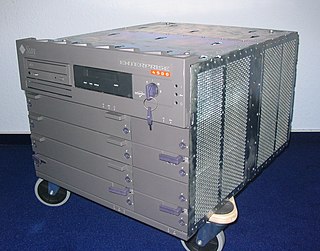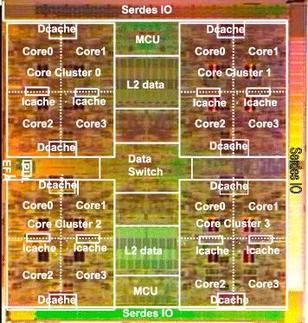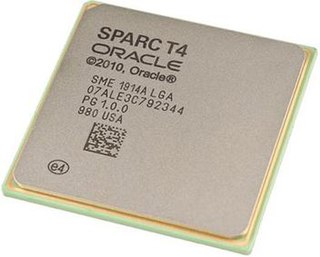Related Research Articles

Sun Microsystems, Inc. was an American technology company that sold computers, computer components, software, and information technology services and created the Java programming language, the Solaris operating system, ZFS, the Network File System (NFS), and SPARC microprocessors. Sun contributed significantly to the evolution of several key computing technologies, among them Unix, RISC processors, thin client computing, and virtualized computing. Notable Sun acquisitions include Cray Business Systems Division, Storagetek, and Innotek GmbH, creators of VirtualBox. Sun was founded on February 24, 1982. At its height, the Sun headquarters were in Santa Clara, California, on the former west campus of the Agnews Developmental Center.

SPARC is a reduced instruction set computer (RISC) instruction set architecture originally developed by Sun Microsystems. Its design was strongly influenced by the experimental Berkeley RISC system developed in the early 1980s. First developed in 1986 and released in 1987, SPARC was one of the most successful early commercial RISC systems, and its success led to the introduction of similar RISC designs from many vendors through the 1980s and 1990s.

Solaris is a proprietary Unix operating system originally developed by Sun Microsystems. After the Sun acquisition by Oracle in 2010, it was renamed Oracle Solaris.

Sun Enterprise is a range of UNIX server computers produced by Sun Microsystems from 1996 to 2001. The line was launched as the Sun Ultra Enterprise series; the Ultra prefix was dropped around 1998. These systems are based on the 64-bit UltraSPARC microprocessor architecture and related to the contemporary Ultra series of computer workstations. Like the Ultra series, they run Solaris. Various models, from single-processor entry-level servers to large high-end multiprocessor servers were produced. The Enterprise brand was phased out in favor of the Sun Fire model line from 2001 onwards.

The Sun Ultra series is a discontinued line of workstation and server computers developed and sold by Sun Microsystems, comprising two distinct generations. The original line was introduced in 1995 and discontinued in 2001. This generation was partially replaced by the Sun Blade in 2000 and that line was in itself replaced by the Sun Java Workstation—an AMD Opteron system—in 2004. In sync with the transition to x86-64-architecture processors, in 2005 the Ultra brand was later revived with the launch of the Ultra 20 and Ultra 40, albeit to some confusion, since they were no longer based on UltraSPARC processors.

Sun Fire is a series of server computers introduced in 2001 by Sun Microsystems. The Sun Fire branding coincided with the introduction of the UltraSPARC III processor, superseding the UltraSPARC II-based Sun Enterprise series. In 2003, Sun broadened the Sun Fire brand, introducing Sun Fire servers using the Intel Xeon processor. In 2004, these early Intel Xeon models were superseded by models powered by AMD Opteron processors. Also in 2004, Sun introduced Sun Fire servers powered by the UltraSPARC IV dual-core processor. In 2007, Sun again introduced Intel Xeon Sun Fire servers, while continuing to offer the AMD Opteron versions as well.

The Sun Blade series is a computer workstation line based on the UltraSPARC microprocessor family, developed and sold by Sun Microsystems from 2000 to 2006. The range replaced the earlier Sun Ultra workstation series.
Sun Microsystems' UltraSPARC T1 microprocessor, known until its 14 November 2005 announcement by its development codename "Niagara", is a multithreading, multicore CPU. Designed to lower the energy consumption of server computers, the CPU typically uses 72 W of power at 1.4 GHz.
Sun-4 is a series of Unix workstations and servers produced by Sun Microsystems, launched in 1987. The original Sun-4 series were VMEbus-based systems similar to the earlier Sun-3 series, but employing microprocessors based on Sun's own SPARC V7 RISC architecture in place of the 68k family processors of previous Sun models.

Rock was a multithreading, multicore, SPARC microprocessor under development at Sun Microsystems. Canceled in 2010, it was a separate project from the SPARC T-Series (CoolThreads/Niagara) family of processors.

Sun Microsystems' UltraSPARC T2 microprocessor is a multithreading, multi-core CPU. It is a member of the SPARC family, and the successor to the UltraSPARC T1. The chip is sometimes referred to by its codename, Niagara 2. Sun started selling servers with the T2 processor in October 2007.
Logical Domains is the server virtualization and partitioning technology for SPARC V9 processors. It was first released by Sun Microsystems in April 2007. After the Oracle acquisition of Sun in January 2010, the product has been re-branded as Oracle VM Server for SPARC from version 2.0 onwards.
The SPARC Enterprise series is a range of UNIX server computers based on the SPARC V9 architecture. It was co-developed by Sun Microsystems and Fujitsu, announced on June 1, 2004, and introduced in 2007. They were marketed and sold by Sun Microsystems, Fujitsu, and Fujitsu Siemens Computers under the common brand of "SPARC Enterprise", superseding Sun's Sun Fire and Fujitsu's PRIMEPOWER server product lines. Codename is APL.
The SPARC64 V (Zeus) is a SPARC V9 microprocessor designed by Fujitsu. The SPARC64 V was the basis for a series of successive processors designed for servers, and later, supercomputers.
Afara Websystems Inc. was a Sunnyvale, California, USA server company whose goal was to build servers surrounding a custom high-throughput CPU architecture, "developing IP traffic management systems that will bring quality-of-service to the next generation of IP access infrastructure." The word "Afara" means "bridge" in the West African Yoruba language.

The UltraSPARC III, code-named "Cheetah", is a microprocessor that implements the SPARC V9 instruction set architecture (ISA) developed by Sun Microsystems and fabricated by Texas Instruments. It was introduced in 2001 and operates at 600 to 900 MHz. It was succeeded by the UltraSPARC IV in 2004. Gary Lauterbach was the chief architect.
The SPARC T3 microprocessor is a multithreading, multi-core CPU produced by Oracle Corporation. Officially launched on 20 September 2010, it is a member of the SPARC family, and the successor to the UltraSPARC T2.
Sun Blade is a line of blade server computer systems sold by Sun Microsystems from 2006 onwards.

The SPARC T4 is a SPARC multicore microprocessor introduced in 2011 by Oracle Corporation. The processor is designed to offer high multithreaded performance, as well as high single threaded performance from the same chip. The chip is the 4th generation processor in the T-Series family. Sun Microsystems brought the first T-Series processor to market in 2005.

SPARC T5 is the fifth generation multicore microprocessor of Oracle's SPARC T series family. It was first presented at Hot Chips 24 in August 2012, and was officially introduced with the Oracle SPARC T5 servers in March 2013. The processor is designed to offer high multithreaded performance, as well as high single threaded performance from the same chip.
References
- 1 2 Ashlee Vance (6 December 2005), "At last, Sun unveils UltraSPARC revival", The Register
- ↑ Timothy Prickett Morgan (22 July 2009), "Sun cranks clocks on Sparc T2 and T2+", The Register
- ↑ Ashlee Vance (13 April 2006), "Sun buffs Opteron, SPARC and Sun Ray", The Register
- ↑ Ashlee Vance (10 April 2007), "Sun and Fujitsu to release 256-thread (M)onster", The Register
- ↑ Agam Shah (8 October 2007), "Sun delivers first UltraSparc T2-based servers", IT World Canada
- ↑ "Oracle Unveils SPARC T3 Processor and SPARC T3 Systems". www.oracle.com. 20 September 2010. Retrieved 21 September 2010.
- ↑ Timothy Prickett Morgan (27 September 2011), "Oracle back in the Unix game with Sparc T3 servers", The Register
- ↑ "Oracle Launches Next Generation SPARC T4 Servers". www.oracle.com. 26 September 2011. Retrieved 25 January 2012.
- ↑ Jean S. Bozman, Matthew Eastwood (April 2012), SPARC Servers: An Effective Choice for Efficiency in the Datacenter, p. 9 (PDF), IDC
- ↑ Timothy Prickett Morgan (27 September 2011), "Oracle rises for Unix server push", The Register
- ↑ Timothy Prickett Morgan (11 October 2011), "Oracle's Sparc T4 prices mask improved value", The Register
- ↑ "Oracle Unveils SPARC Servers with the World's Fastest Microprocessor". www.oracle.com. 26 March 2013. Retrieved 27 March 2013.
- ↑ John Mellor-Crummey (14 January 2014), COMP 422 Parallel Computing: An Introduction (PDF), Rice University, p. 22, archived from the original (PDF) on 22 March 2014, retrieved 21 March 2014
- ↑ Kevin McLaughlin (26 March 2013), "Oracle Unveils Sparc Servers, Touts T5 Processor As 'World's Fastest'", CRN
- ↑ "Oracle Announces Breakthrough Processor and Systems Design with SPARC M7". www.oracle.com. 26 October 2015. Retrieved 30 October 2015.